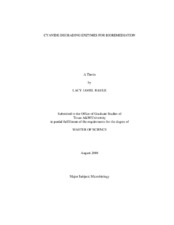| dc.description.abstract | Cyanide-containing waste is an increasingly prevalent problem in today's
society. There are many applications that utilize cyanide, such as gold mining and
electroplating, and these processes produce cyanide waste with varying conditions.
Remediation of this waste is necessary to prevent contamination of soils and water.
While there are a variety of processes being used, bioremediation is potentially a more
cost effective alternative.
A variety of fungal species are known to degrade cyanide through the action of
cyanide hydratases, a specialized subset of nitrilases which hydrolyze cyanide to
formamide. Here I report on previously unknown and uncharacterized nitrilases from
Neurospora crassa, Gibberella zeae, and Aspergillus nidulans. Recombinant forms of
four cyanide hydratases from N. crassa, A. nidulans, G. zeae, and Gloeocercospora
sorghi were prepared after their genes were cloned with N-terminal hexahistidine
purification tags, expressed in Escherichia coli and purified using immobilized metal
affinity chromatography. These enzymes were compared according to their relative
specific activity, pH activity profiles, thermal stability, and ability to degrade cyanide in
the presence of high concentrations of copper and silver. Although all four were relatively similar, the N. crassa cyanide hydratase (CHT)
has the greatest thermal stability and widest pH range where activity remained above
50%. N. crassa also demonstrated the highest rate of cyanide degradation in the
presence of both metals tested. The CHT of A. nidulans and N. crassa have the highest
reaction rate of the four fungal nitrilases evaluated in this work.
These data help determine optimization conditions for the possible use of these
enzymes in the bioremediation of cyanide-containing waste. Similar to known plant
pathogenic fungi, in vivo expression of CHT in both N. crassa and A. nidulans were
induced by growth in the presence of KCN (potassium cyanide). | en |


